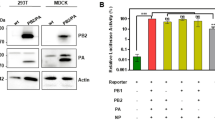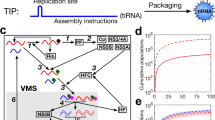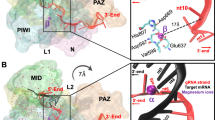Abstract
RNA interference (RNAi) can be used to inhibit viral replication in mammalian cells and therefore could be a powerful new antiviral therapy. Small interfering RNA (siRNA) may be effective for RNAi, but there are some technical problems that must be solved in each case, for example, predicting the effective siRNA target site and targeting heterogeneous sequences in a virus population. We show here that diced siRNA generated from long double-stranded RNA (dsRNA) is highly effective for inducing RNAi in HuH-7 cells harboring hepatitis C virus (HCV) replicons and can overcome variations in the HCV genotype. However, in mammalian cells, long dsRNA induced an interferon response and caused cell death. Here we describe an improvement of this method, U6 promoter-driven expression of long hairpin-RNA with multiple point mutations in the sense strand. This can efficiently silence HCV RNA replication and HCV protein expression without triggering the interferon response or cell death normally caused by dsRNA. In conclusion, intracellular-diced dsRNA efficiently induces RNAi, and, despite the high rate of mutation in HCV, it should be a feasible therapeutic strategy for silencing HCV RNA.
This is a preview of subscription content, access via your institution
Access options
Subscribe to this journal
Receive 12 print issues and online access
$259.00 per year
only $21.58 per issue
Buy this article
- Purchase on Springer Link
- Instant access to full article PDF
Prices may be subject to local taxes which are calculated during checkout





Similar content being viewed by others
References
WHO. Hepatitis C – global prevalence (update). Wkly Epidemiol Rec 2000; 75: 18–19.
Chander G, Sulkowski MS, Jenckes MW, Torbenson MS, Herlong HF, Bass EB et al. Treatment of chronic hepatitis C: a systematic review. Hepatology 2002; 36: S135–S144.
Tsukiyama-Kohara K, Iizuka N, Kohara M, Nomoto A . Internal ribosome entry site within hepatitis C virus RNA. J Virol 1992; 66: 1476–1483.
Tanaka T, Kato N, Cho MJ, Shimotohno K . A novel sequence found at the 3′ terminus of hepatitis C virus genome. Biochem Biophys Res Commun 1995; 215: 744–749.
Bukh J, Miller RH, Purcell RH . Genetic heterogeneity of hepatitis C virus: quasispecies and genotypes. Semin Liver Dis 1995; 15: 41–63.
Martell M, Esteban JI, Quer J, Genesca J, Weiner A, Esteban R et al. Hepatitis C virus (HCV) circulates as a population of different but closely related genomes: quasispecies nature of HCV genome distribution. J Virol 1992; 66: 3225–3229.
Behrens SE, Tomei L, De Francesco R . Identification and properties of the RNA-dependent RNA polymerase of hepatitis C virus. EMBO J 1996; 15: 12–22.
Sullenger BA, Gilboa E . Emerging clinical applications of RNA. Nature 2002; 418: 252–258.
Hannon GJ . RNA interference. Nature 2002; 418: 244–251.
Elbashir SM, Harborth J, Lendeckel W, Yalcin A, Weber K, Tuschl T . Duplexes of 21-nucleotide RNAs mediate RNA interference in cultured mammalian cells. Nature 2001; 411: 494–498.
Jacque JM, Triques K, Stevenson M . Modulation of HIV-1 replication by RNA interference. Nature 2002; 418: 435–438.
Gitlin L, Karelsky S, Andino R . Short interfering RNA confers intracellular antiviral immunity in human cells. Nature 2002; 418: 430–434.
Randall G, Grakoui A, Rice CM . Clearance of replicating hepatitis C virus replicon RNAs in cell culture by small interfering RNAs. Proc Natl Acad Sci USA 2003; 100: 235–240.
Kronke J, Kittler R, Buchholz F, Windisch MP, Pietschmann T, Bartenschlager R et al. Alternative approaches for efficient inhibition of hepatitis C virus RNA replication by small interfering RNAs. J Virol 2004; 78: 3436–3446.
Kapadia SB, Brideau-Andersen A, Chisari FV . Interference of hepatitis C virus RNA replication by short interfering RNAs. Proc Natl Acad Sci USA 2003; 100: 2014–2018.
Wilson JA, Jayasena S, Khvorova A, Sabatinos S, Rodrigue-Gervais IG, Arya S et al. RNA interference blocks gene expression and RNA synthesis from hepatitis C replicons propagated in human liver cells. Proc Natl Acad Sci USA 2003; 100: 2783–2788.
Seo MY, Abrignani S, Houghton M, Han JH . Small interfering RNA-mediated inhibition of hepatitis C virus replication in the human hepatoma cell line Huh-7. J Virol 2003; 77: 810–812.
Yokota T, Sakamoto N, Enomoto N, Tanabe Y, Miyagishi M, Maekawa S et al. Inhibition of intracellular hepatitis C virus replication by synthetic and vector-derived small interfering RNAs. EMBO Rep 2003; 4: 602–608.
Okamoto H, Kurai K, Okada S, Yamamoto K, Lizuka H, Tanaka T et al. Full-length sequence of a hepatitis C virus genome having poor homology to reported isolates: comparative study of four distinct genotypes. Virology 1992; 188: 331–341.
Lohmann V, Korner F, Koch J, Herian U, Theilmann L, Bartenschlager R . Replication of subgenomic hepatitis C virus RNAs in a hepatoma cell line. Science 1999; 285: 110–113.
Kawasaki H, Suyama E, Iyo M, Taira K . siRNAs generated by recombinant human Dicer induce specific and significant but target site-independent gene silencing in human cells. Nucleic Acids Res 2003; 31: 981–987.
Bernstein E, Caudy AA, Hammond SM, Hannon GJ . Role for a bidentate ribonuclease in the initiation step of RNA interference. Nature 2001; 409: 363–366.
Kim DH, Behlke MA, Rose SD, Chang MS, Choi S, Rossi JJ . Synthetic dsRNA Dicer substrates enhance RNAi potency and efficacy. Nat Biotechnol 2005; 23: 222–226.
Takeuchi T, Katsume A, Tanaka T, Abe A, Inoue K, Tsukiyama-Kohara K et al. Real-time detection system for quantification of hepatitis C virus genome. Gastroenterology 1999; 116: 636–642.
Matsumoto M, Kikkawa S, Kohase M, Miyake K, Seya T . Establishment of a monoclonal antibody against human Toll-like receptor 3 that blocks double-stranded RNA-mediated signaling. Biochem Biophys Res Commun 2002; 293: 1364–1369.
Oshiumi H, Matsumoto M, Funami K, Akazawa T, Seya T . TICAM-1, an adaptor molecule that participates in Toll-like receptor 3-mediated interferon-beta induction. Nat Immunol 2003; 4: 161–167.
Takaoka A, Hayakawa S, Yanai H, Stoiber D, Negishi H, Kikuchi H et al. Integration of interferon-alpha/beta signalling to p53 responses in tumour suppression and antiviral defence. Nature 2003; 424: 516–523.
Foy E, Li K, Wang C, Sumpter Jr R, Ikeda M, Lemon SM et al. Regulation of interferon regulatory factor-3 by the hepatitis C virus serine protease. Science 2003; 300: 1145–1148.
Tsukiyama-Kohara K, Tone S, Maruyama I, Inoue K, Katsume A, Nuriya H et al. Activation of the CKI–CDK–Rb–E2F pathway in full genome hepatitis C virus-expressing cells. J Biol Chem 2004; 279: 14531–14541.
Miyagishi M, Taira K . U6 promoter-driven siRNAs with four uridine 3′ overhangs efficiently suppress targeted gene expression in mammalian cells. Nat Biotechnol 2002; 20: 497–500.
Miyagishi M, Taira K . Strategies for generation of an siRNA expression library directed against the human genome. Oligonucleotides 2003; 13: 325–333.
Miyagishi M, Sumimoto H, Miyoshi H, Kawakami Y, Taira K . Optimization of an siRNA-expression system with an improved hairpin and its significant suppressive effects in mammalian cells. J Gene Med 2004; 6: 715–723.
Tanaka H, Tapscott SJ, Trask BJ, Yao MC . Short inverted repeats initiate gene amplification through the formation of a large DNA palindrome in mammalian cells. Proc Natl Acad Sci USA 2002; 99: 8772–8777.
Das AT, Brummelkamp TR, Westerhout EM, Vink M, Madiredjo M, Bernards R et al. Human immunodeficiency virus type 1 escapes from RNA interference-mediated inhibition. J Virol 2004; 78: 2601–2605.
Wilson JA, Richardson CD . Hepatitis C virus replicons escape RNA interference induced by a short interfering RNA directed against the NS5b coding region. J Virol 2005; 79: 7050–7058.
Yanagi M, St Claire M, Emerson SU, Purcell RH, Bukh J . In vivo analysis of the 3′ untranslated region of the hepatitis C virus after in vitro mutagenesis of an infectious cDNA clone. Proc Natl Acad Sci USA 1999; 96: 2291–2295.
Bartenschlager R, Lohmann V . Replication of hepatitis C virus. J Gen Virol 2000; 81: 1631–1648.
Brummelkamp TR, Bernards R, Agami R . A system for stable expression of short interfering RNAs in mammalian cells. Science 2002; 296: 550–553.
Guo JT, Bichko VV, Seeger C . Effect of alpha interferon on the hepatitis C virus replicon. J Virol 2001; 75: 8516–8523.
Tanaka T, Lau JY, Mizokami M, Orito E, Tanaka E, Kiyosawa K et al. Simple fluorescent enzyme immunoassay for detection and quantification of hepatitis C viremia. J Hepatol 1995; 23: 742–745.
Acknowledgements
We express their gratitude to Dr Christoph Seeger (Institute for Cancer Research, Fox Chase Cancer Center, Philadelphia, PA) for his kind gift of the replicon plasmid. We also thank Ms Etsuko Endo for creating the figures. This study was supported by grants from the Ministry of Education, Culture, Sports, Science and Technology of Japan; the Program for Promotion of Fundamental Studies in Health Sciences of the National Institute of Biomedical Innovation of Japan, and the Ministry of Health, Labor and Welfare of Japan.
Author information
Authors and Affiliations
Corresponding author
Rights and permissions
About this article
Cite this article
Watanabe, T., Sudoh, M., Miyagishi, M. et al. Intracellular-diced dsRNA has enhanced efficacy for silencing HCV RNA and overcomes variation in the viral genotype. Gene Ther 13, 883–892 (2006). https://doi.org/10.1038/sj.gt.3302734
Received:
Revised:
Accepted:
Published:
Issue Date:
DOI: https://doi.org/10.1038/sj.gt.3302734
Keywords
This article is cited by
-
Development of short hairpin RNA expression vectors targeting the internal ribosomal entry site of the classical swine fever virus genomic RNA
BMC Biotechnology (2023)
-
A small molecule iCDM-34 identified by in silico screening suppresses HBV DNA through activation of aryl hydrocarbon receptor
Cell Death Discovery (2023)
-
New opportunities for designing effective small interfering RNAs
Scientific Reports (2019)
-
In vivo therapeutic potential of Dicer-hunting siRNAs targeting infectious hepatitis C virus.
Scientific Reports (2014)
-
All for One, One for All: New Combinatorial RNAi Therapies Combat Hepatitis C Virus Evolution
Molecular Therapy (2012)



